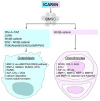Progress in Composite Hydrogels and Scaffolds Enriched with Icariin for Osteochondral Defect Healing
- PMID: 36286148
- PMCID: PMC9602414
- DOI: 10.3390/gels8100648
Progress in Composite Hydrogels and Scaffolds Enriched with Icariin for Osteochondral Defect Healing
Abstract
Osteochondral structure reconstruction by tissue engineering, a challenge in regenerative medicine, requires a scaffold that ensures both articular cartilage and subchondral bone remodeling. Functional hydrogels and scaffolds present a strategy for the controlled delivery of signaling molecules (growth factors and therapeutic drugs) and are considered a promising therapeutic approach. Icariin is a pharmacologically-active small molecule of prenylated flavonol glycoside and the main bioactive flavonoid isolated from Epimedium spp. The in vitro and in vivo testing of icariin showed chondrogenic and ostseoinductive effects, comparable to bone morphogenetic proteins, and suggested its use as an alternative to growth factors, representing a low-cost, promising approach for osteochondral regeneration. This paper reviews the complex structure of the osteochondral tissue, underlining the main aspects of osteochondral defects and those specifically occurring in osteoarthritis. The significance of icariin's structure and the extraction methods were emphasized. Studies revealing the valuable chondrogenic and osteogenic effects of icariin for osteochondral restoration were also reviewed. The review highlighted th recent state-of-the-art related to hydrogels and scaffolds enriched with icariin developed as biocompatible materials for osteochondral regeneration strategies.
Keywords: bone morphogenetic proteins; cartilage; flavonoids; hydrogel; osteoarthritis; osteochondral defect.
Conflict of interest statement
The authors declare no conflict of interest.
Figures




Similar articles
-
Icariin conjugated hyaluronic acid/collagen hydrogel for osteochondral interface restoration.Acta Biomater. 2018 Jul 1;74:156-167. doi: 10.1016/j.actbio.2018.05.005. Epub 2018 May 4. Acta Biomater. 2018. PMID: 29734010
-
Treatment of osteochondral defects in the rabbit's knee joint by implantation of allogeneic mesenchymal stem cells in fibrin clots.J Vis Exp. 2013 May 21;(75):e4423. doi: 10.3791/4423. J Vis Exp. 2013. PMID: 23728213 Free PMC article.
-
Bioactive scaffolds for osteochondral regeneration.J Orthop Translat. 2018 Dec 26;17:15-25. doi: 10.1016/j.jot.2018.11.006. eCollection 2019 Apr. J Orthop Translat. 2018. PMID: 31194079 Free PMC article. Review.
-
Osteochondral Tissue Engineering Dilemma: Scaffolding Trends in Regenerative Medicine.Stem Cell Rev Rep. 2023 Aug;19(6):1615-1634. doi: 10.1007/s12015-023-10545-x. Epub 2023 Apr 19. Stem Cell Rev Rep. 2023. PMID: 37074547 Review.
-
Growth and Regeneration of Osteochondral Cells in Bioactive Niche: A Promising Approach for Osteochondral Tissue Repair.ACS Appl Bio Mater. 2022 Jun 20;5(6):2676-2688. doi: 10.1021/acsabm.2c00125. Epub 2022 Jun 6. ACS Appl Bio Mater. 2022. PMID: 35658402
Cited by
-
Facile Construction of Hybrid Hydrogels with High Strength and Biocompatibility for Cranial Bone Regeneration.Gels. 2022 Nov 17;8(11):745. doi: 10.3390/gels8110745. Gels. 2022. PMID: 36421567 Free PMC article.
-
Enhanced bone regeneration via local low-dose delivery of PTH1-34 in a composite hydrogel.Front Bioeng Biotechnol. 2023 Jul 3;11:1209752. doi: 10.3389/fbioe.2023.1209752. eCollection 2023. Front Bioeng Biotechnol. 2023. PMID: 37465690 Free PMC article.
-
Icariin: A Promising Natural Product in Biomedicine and Tissue Engineering.J Funct Biomater. 2023 Jan 12;14(1):44. doi: 10.3390/jfb14010044. J Funct Biomater. 2023. PMID: 36662090 Free PMC article. Review.
References
-
- Sacitharan P.K. Ageing and osteoarthritis. In: Harris J., Korolchuk V., editors. Biochemistry and Cell Biology of Ageing: Part II Clinical Science. Subcellular Biochemistry. Springer; Singapore: 2019. pp. 123–159. - PubMed
-
- He L., He T., Xing J., Zhou Q., Fan L., Liu C., Chen Y., Wu D., Tian Z., Liu B., et al. Bone marrow mesenchymal stem cell-derived exosomes protect cartilage damage and relieve knee osteoarthritis pain in a rat model of osteoarthritis. Stem Cell Res. Ther. 2020;11:276. doi: 10.1186/s13287-020-01781-w. - DOI - PMC - PubMed
Publication types
Grants and funding
LinkOut - more resources
Full Text Sources
Miscellaneous

